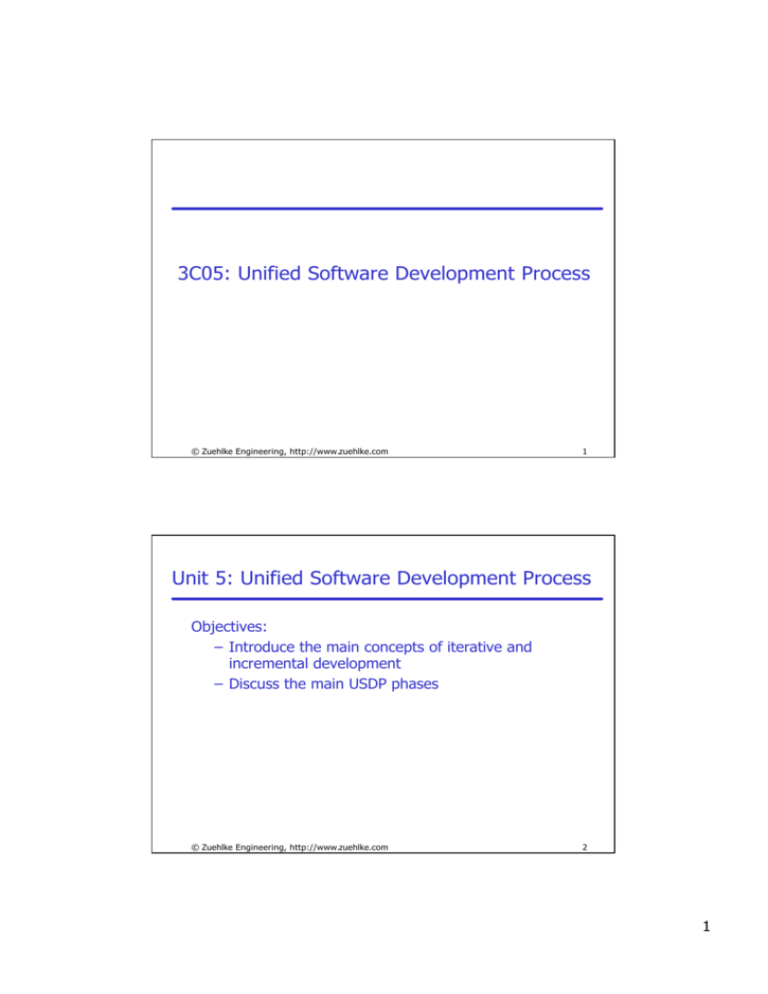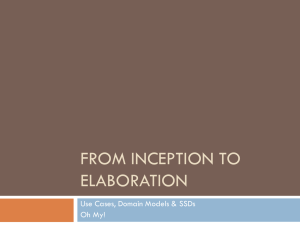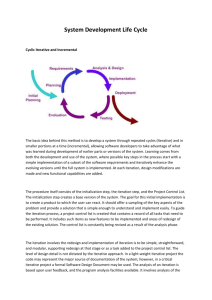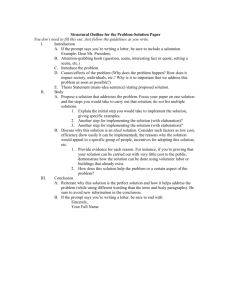3C05: Unified Software Development Process Unit 5: Unified
advertisement

3C05: Unified Software Development Process © Zuehlke Engineering, http://www.zuehlke.com 1 Unit 5: Unified Software Development Process Objectives: – Introduce the main concepts of iterative and incremental development – Discuss the main USDP phases © Zuehlke Engineering, http://www.zuehlke.com 2 1 USDP • USDP is an industry standard software development process – Free! – The generic process for the UML • USDP is: – Use-case and risk driven – Architecture centric – Iterative and incremental • For reference: Ivar Jacobson, Grady Booch, James Rumbaugh: The Unified Software Development Process. Addison Wesley. 1999 © Zuehlke Engineering, http://www.zuehlke.com 3 USDP for your project… • USDP is a generic software engineering process. It has to be customised (instantiated) for your project: – In-house standards – Document templates – Tools – Databases – Lifecycle modifications • Rational Unified Process is an instantiation of USDP. RUP is a product marketed and owned by Rational Corporation • RUP also has to be instantiated for your project! © Zuehlke Engineering, http://www.zuehlke.com 4 2 Iterations • Iterations are the key to the USDP • Each iteration is like a mini-project including: – Planning – Analysis and design – Integration and test – An internal or external release – The result of an iteration is an increment • We arrive at a final product release through a sequence of iterations • Iterations contain workflows • Iterations are organised into phases © Zuehlke Engineering, http://www.zuehlke.com 5 Iteration Workflows USDP specifies 5 core workflows Requirements Analysis Planning Each iteration may contain all of the core workflows but with different emphasis depending on where the iteration is in the lifecycle (see later!) Design An iteration Implementation Test Assessment Specific Activities © Zuehlke Engineering, http://www.zuehlke.com 6 3 Iterations may overlap Iteration 1 Iteration 2 Iteration 3 In order to allow parallel development and flexible working in large teams, iterations can, and often do, overlap. In the example above, Iteration 1 overlaps significantly with iteration 2 This requires Careful planning © Zuehlke Engineering, http://www.zuehlke.com 7 Increments • Each iteration generates internal (or external) releases of various artefacts which together constitute a baseline • A baseline is a set of reviewed and approved artefacts that: – Provides an agreed basis for further review and development – Can be changed only through a formal procedure such as configuration and change management • An increment is the difference between the release of one iteration and the release of the next – The result of an iteration is an increment © Zuehlke Engineering, http://www.zuehlke.com 8 4 USDP Lifecycle • The USDP lifecycle is divided into a sequence of phases • Each phase may include many iterations – The exact number of iterations per phase depends on the size of the project! – One iteration per phase for small projects • Each phase concludes with a major milestone © Zuehlke Engineering, http://www.zuehlke.com 9 USDP Phases Milestone Life-cycle Objectives Life-cycle Architecture Inception Phase Iterations 5 Core Workflows Iter 1 R A D Elaboration Iter 2 I T … Iter 3 … Initial Operational Capability Product Release Construction Transition Iter 4 … Iter 5 Iter 6 … … The exact number of iterations per Phase depends on the size of the project! We have assumed a that this particular project lasts 18 months. © Zuehlke Engineering, http://www.zuehlke.com 10 5 Phases and Workflows Inception Elaboration Requirements Construction Transition Amount of work Analysis Design Implementation Test Preliminary Iterations I1 I2 In In+1 In+2 Im Im+1 © Zuehlke Engineering, http://www.zuehlke.com 11 Time for a typical project 10% •If we consider a project of “typical” difficulty, then this is how the total time for the project is likely to be distributed over the phases 10% Inception 30% Elaboration 50% Construction Transition © Zuehlke Engineering, http://www.zuehlke.com 12 6 Time for a difficult project 7% 20% 40% • If we consider a project of greater than normal difficulty, then this is how the total time for the project is likely to be distributed over the phases Inception • Note that for more difficult projects more time is spent Elaboration Construction in the early phases Transition 33% © Zuehlke Engineering, http://www.zuehlke.com 13 Resource for a typical project 10% •If we consider a project of “typical” difficulty, then this is how the total resource for the project is likely to be utilised over the phases 5% 20% Inception Elaboration Construction Transition 65% © Zuehlke Engineering, http://www.zuehlke.com 14 7 Resource for a difficult project 8% 8% • If we consider a project of greater than normal difficulty, then this is how the total resource for the project is likely to be distributed over the phases 24% Inception • Note that for more difficult Elaboration projects more resource is Construction used in the early phases Transition 60% © Zuehlke Engineering, http://www.zuehlke.com 15 Phases • For each phase we will consider: – The goal for the phase – The focus in terms of the core workflows – The milestone at the end of the phase © Zuehlke Engineering, http://www.zuehlke.com 16 8 Inception Inception Elaboration Construction © Zuehlke Engineering, http://www.zuehlke.com Transition 17 Inception - Goals • • • • • • Establish feasibility of the project Create a business case Capture key requirements Scope the system Identify critical risks Create proof of concept prototype © Zuehlke Engineering, http://www.zuehlke.com 18 9 Phases and Workflows Requirements Inception Elaboration Construction Transition Amount of work Analysis Design Implementation Test Preliminary Iterations I1 I2 In In+1 In+2 Im Im+1 © Zuehlke Engineering, http://www.zuehlke.com 19 Inception - Focus • Requirements – establish business case, scope and core requirements • Analysis – establish feasibility • Design – design proof of concept or technical prototypes • Implementation – build the proof of concept prototype • Test – not generally applicable N.B. The blue bars indicate approximately the relative amount of resource needed © Zuehlke Engineering, http://www.zuehlke.com 20 10 Life Cycle Objectives • Conditions of satisfaction: – System scope has been defined – Key requirements for the system have been captured. These have been defined and agreed with the stakeholders – An architectural vision exists. This is just a sketch at this stage – A Risk Assessment – A Business Case – Project feasibility is confirmed – The stakeholders agree on the objectives of the project © Zuehlke Engineering, http://www.zuehlke.com 21 Elaboration Inception Elaboration Construction © Zuehlke Engineering, http://www.zuehlke.com Transition 22 11 Elaboration - Goals • • • • Create an executable architectural baseline Refine Risk Assessment Define quality attributes (defect rates etc.) Capture use-cases to 80% of the functional requirements • Create a detailed plan for the construction phase • Formulate a bid which includes resources, time, equipment, staff and cost © Zuehlke Engineering, http://www.zuehlke.com 23 Phases and Workflows Requirements Inception Elaboration Construction Transition Amount of work Analysis Design Implementation Test Preliminary Iterations I1 I2 © Zuehlke Engineering, http://www.zuehlke.com In In+1 In+2 Im Im+1 24 12 How many use-cases? • Our goal is to find sufficient use-cases to allow us to build a system • Aim to identify about 80% of the use-cases based on a consideration of functional requirements – The other 20% will come out in later phases if important • Aim to model in detail only about 40% to 80% of the set of identified use-cases • For each use-case modelled in detail, only a small fraction of the possible scenarios may need to be modelled Model just enough use-cases to capture the information you need! © Zuehlke Engineering, http://www.zuehlke.com 25 Elaboration - Focus • Requirements – refine system scope and requirements • Analysis – establish what to build • Design – create a stable architecture • Implementation – build the architectural baseline • Test – test the architectural baseline © Zuehlke Engineering, http://www.zuehlke.com 26 13 Life Cycle Architecture • Conditions of satisfaction: – A resilient, robust executable architectural baseline has been created – The Risk Assessment has been updated – A project plan has been created to enable a realistic bid to be formulated – The business case has been verified against the plan – The stakeholders agree to continue © Zuehlke Engineering, http://www.zuehlke.com 27 Construction Inception Elaboration Construction Transition © Zuehlke Engineering, http://www.zuehlke.com 28 14 Construction - Goals • Completing use-case identification, description and realisation • Finish analysis, design, implementation and test • Maintain the integrity of the system architecture • Revise the Risk Assessment © Zuehlke Engineering, http://www.zuehlke.com 29 Phases and Workflows Requirements Inception Elaboration Construction Transition Amount of work Analysis Design Implementation Test Preliminary Iterations I1 I2 © Zuehlke Engineering, http://www.zuehlke.com In In+1 In+2 Im Im+1 30 15 Construction - Focus • Requirements – uncover any requirements that had been missed • Analysis – finish the analysis model • Design – finish the design model • Implementation – build the Initial Operational Capability • Test – test the Initial Operational Capability © Zuehlke Engineering, http://www.zuehlke.com 31 Plan for two lines of work… About 10 to 20% of the resources will not contribute directly to the next release! Primary Tasks Next Release 80% Next Release Secondary Tasks Plan for this! 10-20% © Zuehlke Engineering, http://www.zuehlke.com 32 16 Primary and secondary tasks • Primary tasks: – Everything that contributes directly to the next increment • Secondary tasks: – Everything else! – Attack risks with behavioural prototypes – Solve critical problems with taskforces (tiger teams) – Research into problem and solution domains – Bug tracking and reporting © Zuehlke Engineering, http://www.zuehlke.com 33 Initial Operational Capability • Conditions of satisfaction: – The product is ready for beta testing in the user environment © Zuehlke Engineering, http://www.zuehlke.com 34 17 Transition Inception Elaboration Construction Transition © Zuehlke Engineering, http://www.zuehlke.com 35 Transition - Goals • • • • • • • Correct defects Prepare the users site for the new software Tailor the software to operate at the users site Modify software if unforeseen problems arise Create user manuals and other documentation Provide customer consultancy Conduct post project review © Zuehlke Engineering, http://www.zuehlke.com 36 18 Phases and Workflows Requirements Inception Elaboration Construction Transition Amount of work Analysis Design Implementation Test Preliminary Iterations I1 I2 In In+1 In+2 Im Im+1 © Zuehlke Engineering, http://www.zuehlke.com 37 Transition - Focus • Requirements – not applicable • Analysis – not applicable • Design – modify the design if problems emerge in beta testing • Implementation – tailor the software for the users site and correct problems uncovered in beta testing • Test – beta testing and acceptance testing at the users site © Zuehlke Engineering, http://www.zuehlke.com 38 19 Product Release • Conditions of satisfaction: – Beta testing, acceptance testing and defect repair are finished – The product is released into the user community © Zuehlke Engineering, http://www.zuehlke.com 39 Key Points • USDP is the iterative and incremental software engineering process for the UML • USDP has four phases: – Inception – Elaboration – Construction – Transition • Each phase may have one or more iterations • Each iteration has five iteration workflows – Requirements,Analysis,Design,Implementation,Test © Zuehlke Engineering, http://www.zuehlke.com 40 20






